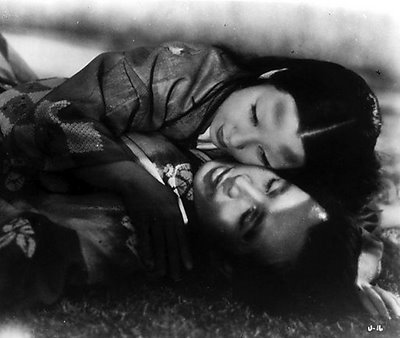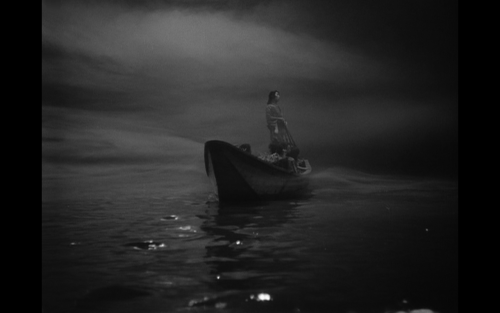Directed by Kenji Mizoguchi
Produced by Masaichi Nagata
Written by Yoshikata Yoda
Cinematography by Kazuo Miyagawa
Music by Fumio Hayasaka
Edited by Mitsuzo Miyata
Country/Language- Japan/Japanese
Cast- Masayuki Mori, Machiko Kyo, Kinuyo Tanaka, Sakae Ozawa, Mitsuko Mito and Kikue Mori

Ugetsu or Ugetsu Monogotari, the original Japanese title, is perhaps the most widely seen of all of director Kenji Mizoguchi's films (Sansho the Bailiff is another one). It was an important film for Mizoguchi because it was the first film that brought him international renown.
Ugetsu made its appearance in international film circles closely on the heels of Rashomon, which was an international sensation and gave its director Akira Kurosawa the sort of reputation no Japanese director had enjoyed before. Mizoguchi, who started his career in the 1920s as a director of silent films, was a relative unknown outside his native country. The fact that a Japanese film could appeal to international audiences was proved by Kurosawa's film, which may have prompted Mizoguchi to try the same.
Incidentally, both the films do share a few similarities. Masayuki Mori and Machiko Kyo, who played the murdered samurai and his wife in Rashomon, also essayed important roles in Ugetsu, the cinematographer and the music composer for both the films were the same, and the plots for both the films were created by combining two short stories. And yes, both films won the Silver Lion at the Venice Film Festival.
Though Ugetsu bought Mizoguchi the worldwide attention he so deserved, he was already nearing the end of his career. He would die of leukemia three years later, at the age of 58.
Produced by Masaichi Nagata
Written by Yoshikata Yoda
Cinematography by Kazuo Miyagawa
Music by Fumio Hayasaka
Edited by Mitsuzo Miyata
Country/Language- Japan/Japanese
Cast- Masayuki Mori, Machiko Kyo, Kinuyo Tanaka, Sakae Ozawa, Mitsuko Mito and Kikue Mori

Ugetsu or Ugetsu Monogotari, the original Japanese title, is perhaps the most widely seen of all of director Kenji Mizoguchi's films (Sansho the Bailiff is another one). It was an important film for Mizoguchi because it was the first film that brought him international renown.
Ugetsu made its appearance in international film circles closely on the heels of Rashomon, which was an international sensation and gave its director Akira Kurosawa the sort of reputation no Japanese director had enjoyed before. Mizoguchi, who started his career in the 1920s as a director of silent films, was a relative unknown outside his native country. The fact that a Japanese film could appeal to international audiences was proved by Kurosawa's film, which may have prompted Mizoguchi to try the same.
Incidentally, both the films do share a few similarities. Masayuki Mori and Machiko Kyo, who played the murdered samurai and his wife in Rashomon, also essayed important roles in Ugetsu, the cinematographer and the music composer for both the films were the same, and the plots for both the films were created by combining two short stories. And yes, both films won the Silver Lion at the Venice Film Festival.
But the similarities end there. When it comes to plot, style, tone and performance, the paths of both the films tread entirely different paths. Ugetsu stays clear of any moralising we may hear in Rashomon, despite the theme being about human vanity. Where the tempo in Rashomon is raised to a feverish pitch, and the acting broad (What else could you expect from someone like Toshiro Mifune?), the tempo and acting in the latter film are restrained.
Mizoguchi tells his story in a more serene way, in the manner of a Buddhist fable. Set in 16th century Japan, ravaged by civil war, the film is centred on two families, that of Genjuro (Masayuki Mori), a potter, who hopes to make the most of the war for his business, and his brother Tobei (Sakae Ozawa), who is driven by his desire to become a samurai. Their wives, Miyagi (Kinuyo Tanaka), and Ohama (Mitsuko Mito), are sceptical of their ambitions, since they are motivated by greed. Unmindful of their wives' advice and the eventual tragedy that befalls them, the two carry on. While Tobei becomes a samurai through fraud, Genjuro is enchanted by Lady Wakasa (Machiko Kyo), who vamps him.
What gives the film its uniqueness is its almost uncanny blend of the real and the ethereal, factors that are often indistinguishable in the film. One could argue that it holds true even in real life, where the illusory is often taken for being real. It is not the characters alone who are unable to differentiate the real from the unreal; we, the viewers, are also deceived in our perception of this seemingly two sides of the coin, and credit has to go to the impeccable artistry of Mizoguchi.
By now, it would have become obvious to you that the heart of the film has its roots in Buddhist thought, which abounds with themes of how man is led to suffering as a result of his own desires and vanity. But there is hardly any moralising in the film- Mizoguchi is content with simply presenting us with the story and does not want any character to stand in as a mouthpiece for his views.
The mood that the film evokes is one of mysticism, and this mood is evoked through Mizoguchi's mise-en-scene, his use of graceful long takes and complex camera movements. Kazuo Miyagawa delivers some of the most beautiful images through his magnificent use of the crane shot. The actors are, for the most part, framed in medium to long shot- even in scenes of dramatic intensity, Mizoguchi prefers to keep the camera distant. The only close-up I can recall is that of Miyagi towards the end of the film. The distanced view that pervades through the film embodies a spirit of detachment, which again has its roots in Buddhist thought.
The score by Fumio Hayasaka also deserves to be mentioned, since it is a vital contributor to the film's mood. While his score for Rashomon used a lot of Western themes (like Ravel's Bolero), the music here is largely Oriental (at least to my knowledge).


